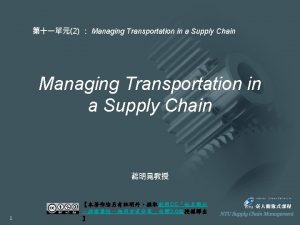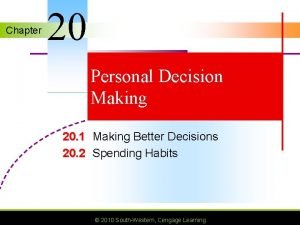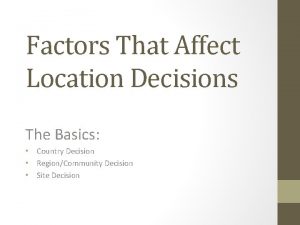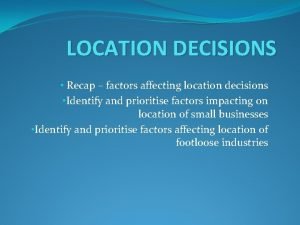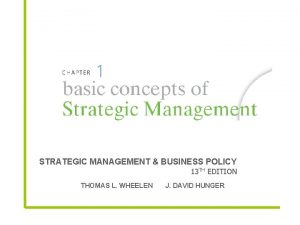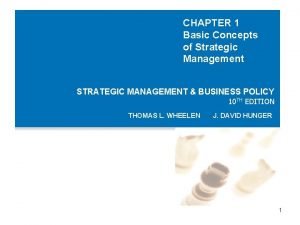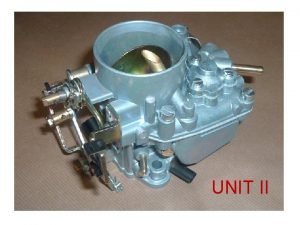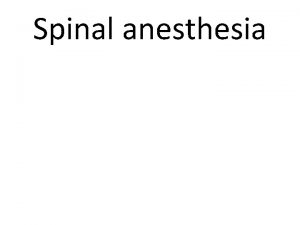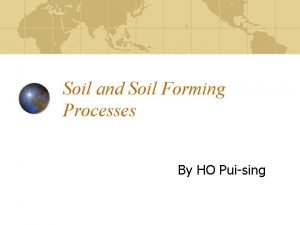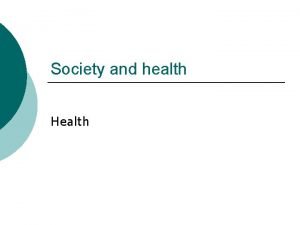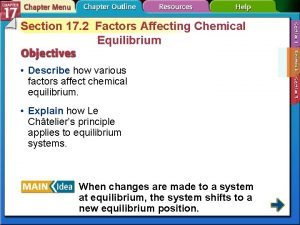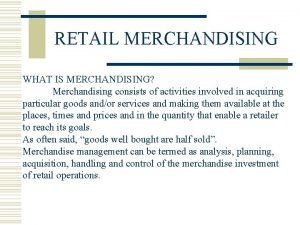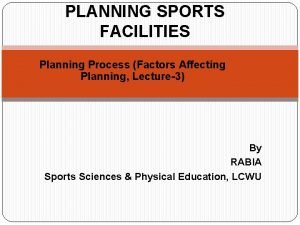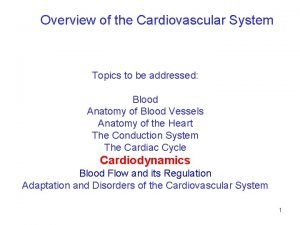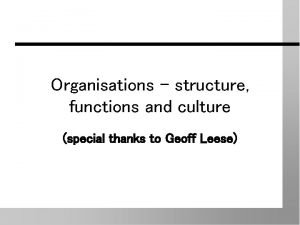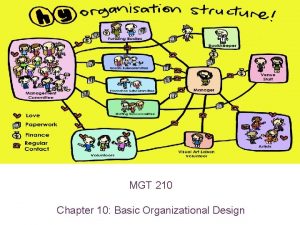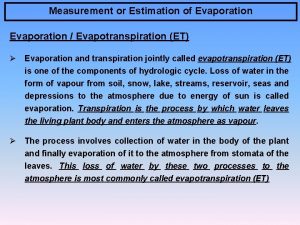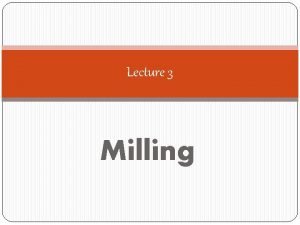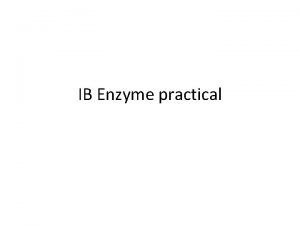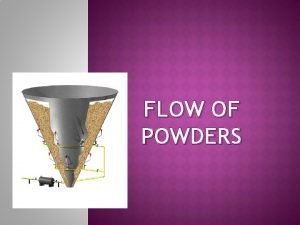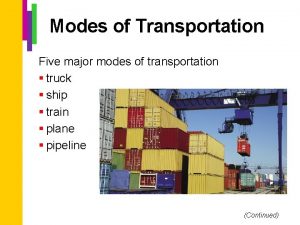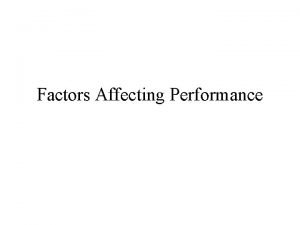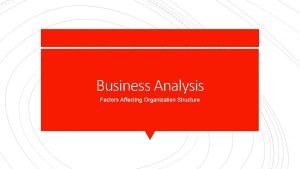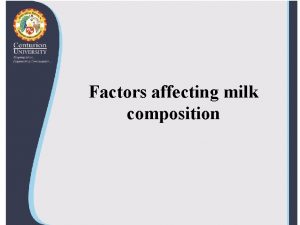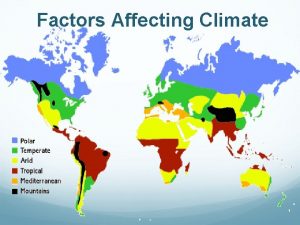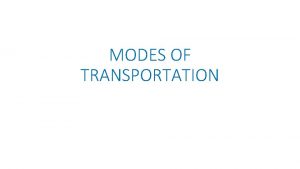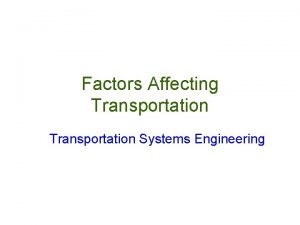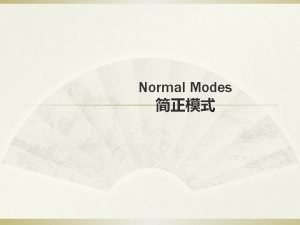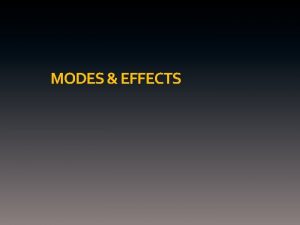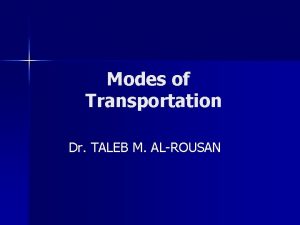Outline Factors affecting transportation decision Key modes of
















































- Slides: 48


Outline ► Factors affecting transportation decision ► Key modes of transport and major issues ► Transportation System Design ► Tradeoffs in transportation design 》Transportation and inventory: Choice of mode 》Transportation and inventory: Consolidation 》Transportation and service: Transit points at Merloni ► Tailored Transportation ► Routing and scheduling in transportation 2

Factors Affecting Carrier Decisions ► Vehicle-related cost: lease or purchase the vehicles ► Fixed operating cost: terminals, airport gates, and labor ► Trip-related cost: length, duration ► Quantity related cost: loading, unloading, proportion of fuel ► Overhead cost: planning, scheduling, IT investments 本作品轉載自Microsoft Office 2007多媒體藝廊,依據 Microsoft服務合約及著作權法第 46、52、65條合理使用。 本作品轉載自Microsoft Office 2007多媒體藝廊,依 據Microsoft服務合約及著作 權法第 46、52、65條合理 使用。 3 本作品轉載自Microsoft Office 2007多媒體藝廊,依據 Microsoft服務合約及著作權法 第 46、52、65條合理使用。

Factors Affecting Shippers Decisions ► Transportation cost ► Inventory cost ► Facility cost ► Processing cost ► Service level cost: delivery commitment 本作品轉載自Microsoft Office 2007多媒體藝廊, 依據Microsoft服務合約 及著作權法第 46、52、 65條合理使用。 4 本作品轉載自 Microsoft Office 2007多 媒體藝廊,依 據Microsoft服 務合約及著作 權法第 46、52、 65條合理使用。 本作品轉載自Microsoft Office 2007多媒體藝廊,依據 Microsoft服務合約及著作權法 第 46、52、65條合理使用。

Transportation Modes ► Trucks 》 TL 》 LTL ► Rail 》 Carload ► Air 本作品轉載自Microsoft Office 2007多媒體藝廊, 依據Microsoft服務合約及 著作權法第 46、52、65 條合理使用。 ► Package Carriers ► Water ► Pipeline ► Intermodal 本作品轉載自Microsoft Office 2007多媒體藝廊,依據Microsoft服務 合約及著作權法第 46、52、65條合理使用。 5

Truckload (TL) ► Average revenue per ton mile (1998) = 9. 13 cents ► Average haul = 289 miles ► Average Capacity = 42, 000 - 50, 000 lb. ► Low fixed and variable costs ► Major Issues 》 Utilization: economies of scale 》 Consistent service 》 Backhauls 本作品轉載自Microsoft Office 2007多媒體藝 廊,依據Microsoft服務合約及著作權法第 46、 52、65條合理使用。 6

Less Than Truckload (LTL) ► Average revenue per ton-mile (1998) = 26. 12 cents ► Average haul = 629 miles ► Higher fixed costs (terminals) and low variable costs ► Major Issues 》 Location of consolidation facilities 》 Utilization (load assignment) 》 scheduling and routing of pickup and delivery 》 Customer service 本作品轉載自Microsoft Office 2007多媒體藝廊, 依據Microsoft服務合約 及著作權法第 46、52、 65條合理使用。 7 本作品轉載自Microsoft Office 2007多媒體藝廊,依據 Microsoft服務合約及著作權法第 46、52、65條合理使用。 本作品轉載自Microsoft Office 2007 多媒體藝廊,依據Microsoft服務合 約及著作權法第 46、52、65條合理 使用。

Rail ► Average revenue / ton-mile (1998) = 2. 40 cents ► Average haul = 722 miles ► Average load = 80 tons ► Key Issues 》Scheduling to minimize delays / improve service 》Off track delays (at pick up and delivery end) 》Yard operations 》Variability of delivery times 8

Air > Average revenue / ton-mile (1998) = 56. 25 cents > Average haul = 1260 miles > Key Issues 》 Location/Number of hubs 》 Location of fleet bases / crew bases 》 Schedule optimization 》 Fleet assignment 》 Maintenance schedule 》 Crew scheduling 》 Yield management (price management) 9

Package Carriers > Expensive but offer rapid, reliable service > Value-added services: 》 Order tracking 》 One-stop shipping > Key factors: 》 Consolidation of shipments 》 Location and capacity of transfer points 》 Information capability 10

Water > Revenue/Ton-Mile (1998) = 0. 73 cents > Average length of haul: 》 Rivers/Canals 481 》 Great lakes 509 》 Coastwise 1653 > Issue: 》 Delays at ports, customs 》 Management of containers used 11

Pipeline > Transport petroleum and related products, natural gas > Revenue/Ton-Mile (1998): 1. 37 > Average length of haul 》Crude 761 》Products 394 > Stable and large flow applied 12

Intermodal > Use more than one mode of transportation to move a shipment to destination > Examples: piggyback, fishyback, birdyback > Key issues: 》Exchange of information to facilitate shipment transfer between different modes 13

Design Options for Transportation Network --- Direct Shipment Network > Replenishment size close to TL 14

Design Options for Transportation Network --- Direct Shipping with Mike Runs > Eliminate warehouse and consolidate the shipments from suppliers or to customers 15

Design Options for Transportation Network --- Via Central Distribution Center > Reduce inbound costs > Cross-ducking DC 16

Design Options for Transportation Network --- Via Distribution Center Using Mike Runs > Consolidate local small shipments DC 17

Pros and Cons of Different Transportation Networks Pros Cons Direct shipping Simple to coordinate Large shipping lot size Direct shipping with milk run Lower cost for small lots Lower inventories Increased coordination complexity Via central DC with inventory storage Lower inbound transportation cost Increased inventory cost Increased handling at DC Via central DC with cross-dock Very low inventory Increased coordination Lower cost through consolidation complexity Via DC using milk run Lower outbound cost for small lots Tailored network Best matches needs of individual Highest coordination product and store complexity 18 Further increase in coordination complexity

Trade-Offs in Transportation Design > Transportation and inventory tradeoff 》Choice of transportation modes 》Inventory aggregation > Transportation cost and customer responsiveness trade-off 19

Impact of Transportation Modes 20 Rail TL LTL Packag e Air Water Lot size 5 4 3 1 2 6 Safety inventory 5 4 3 1 2 6 In-transit inventory 5 4 3 1 2 6 Transportation cost 2 3 4 6 5 1 Transportation time 5 3 4 1 2 6

Choice of Mode: Eastern Electric Corporation > Annual demand = 120, 000 motors > Cost per motor = $120 > Each motor weighs 10 pounds > Current order size = 3, 000 motors > Safety stock carried = 50% of demand during delivery lead time > Holding cost = 25%, annual cost of H = $120 0. 25 = $30 21

Eastern Electric Corporation Carrier 22 Range of Quantity Shipped (cwt. ) Shipping Cost ($/cwt. ) AM railroad 200 + 6. 50 Northeast Trucking 100 + 7. 50 Golden Freightways 50 – 150 8. 00 Golden Freightways 150 – 250 6. 00 Golden Freightways 250 – 400 4. 00 Golden Freightways (new) 400 3. 00

Example: AM Rail Proposal > Minimum shipment 20, 000 lb. or 2, 000 motors. Replenishment lead time L = 5 + 1 = 6 days. Q = 2, 000 motors > Cycle inventory = Q/2 = 2, 000/2 = 1, 000 > Safety inventory = L/2 = (6/2)(120, 000/365) = 986 > In-transit inventory = 120, 000 (5/365) = 1, 644 > Total average inventory = 1, 000 + 986 + 1, 644 = 3, 630 > Annual holding cost using AM Rail = 3, 630 30 = $108, 900 > Annual transportation cost = 120, 000 0. 65 = $78, 000 > Total annual cost for inventory and transportation using AM Rail is $186, 900 23

Eastern Electric Corporation 24

Physical Inventory Aggregation: Inventory vs. Transportation cost > As a result of physical aggregation 》 Inventory costs decrease 》 Inbound transportation cost decreases 》 Outbound transportation cost increases > Applications: 》 Inventory and facility costs are higher 》 Products with large value-to-weight ratio or high demand uncertainty or customer orders are larger 25

Inventory Aggregation at High. Med > Highval (worth $200, . 1 lbs/unit) demand in each of 24 territories, H = 2, H = 5 > Lowval (worth $30/unit, 0. 04 lbs/unit) demand in each territory, L = 20, L = 5 > CSL in each territory is 0. 997 for each product. Holding cost is 25%. > UPS rate: $0. 66 + 0. 26 x (every 4 weeks for replenishments) 26

Inventory Aggregation at High. Med > Option A: keep the current but start replenishing inventory once a week > Option B: Eliminate inventories in the territories, aggregate all inventories in a finished goods warehouse at Madison, and replenish the warehouse once a week 》 Fed. Ex rate: $5. 53 + 0. 53 x (one-week lead time to replenish goods at Madison. An average customer order is for 1 unit of High. Val and 10 units of Low. Val) 27

Inventory Aggregation at High. Med > Current situation: 》 Replenishment lead time L = 1 week 》 Reorder interval T = 4 weeks 》 CSL = 0. 997 》 High. Val inventory costs at each territory: 5 Average lot size QH = 4 2 = 8 5 Safety stock = F-1(CSL) T+L = F-1(0. 997) = 30. 7 5 Total inventory = 8 / 2 + 30. 7 = 34. 7 》 For 24 territories, High. Val invetory = 34. 7 24 = 832. 8 》 Low. Val inventory costs at each territory: 5 Average lot size QL = 4 20 = 80 5 Safety stock = F-1(CSL) T+L = F-1(0. 997) 5 Total inventory = 80 / 2 + 30. 7 = 70. 7 》 For 24 territories, High. Val invetory = 70. 7 24 = 1696. 8 28 = 30. 7

Inventory Aggregation at High. Med > Current situation: 》 Annual inventory holding cost = (832. 8 $200 + 1696. 8 $30 ) 0. 25 = $54, 366 》 Transportation cost: 5 Average weight of each replenishment order = 0. 1 QH + 0. 04 QL = 0. 1 8 + 0. 04 80 = 4 lbs 5 Shipping cost per replenishment order $0. 66 + $0. 26 4 = $1. 7 》 Annual transportation cost for 24 territories = $1. 7 13 24 = $530. 4 》 Total cost = $54, 366 + $530. 4 = $54, 896. 4 29

Inventory Aggregation at High. Med 30 Current Scenario Option A Option B Number of stocking locations 24 24 1 Reorder interval 4 weeks 1 week High. Val cycle inventory 96 units 24 units High. Val safety inventory 736. 8 units 466 units 95. 2 units High. Val inventory 832. 8 units 490 units 119. 2 units Low. Val cycle inventory 960 units 240 units Low. Val safety inventory 736. 8 units 466 units 95. 2 units Low. Val inventory 1, 696. 8 units 706 units 335. 2 units Annual inventory cost $54, 366 $29, 795 $8, 474 Shipment type Replenishment Customer order Shipment size 8 High. Val + 80 Low. Val 2 High. Val + 20 Low. Val 1 High. Val + 10 Low. Val Shipment weight 4 lbs 1 lb. 0. 5 lb. Annual transportation cost $530 $1, 148 $14, 464 Total annual cost $54, 896 $30, 943 $22, 938

Inventory Aggregation at High. Med > If shipment size to customer is 0. 5 H + 5 L, total cost of option 2 increases to $36, 729. 》 Average weight of each customer order = 0. 1 0. 5 + 0. 04 5 = 0. 25 lbs 》 Shipping cost per customer order = $5. 53 + 0. 53 0. 25 = $5. 66 》 Number of customer orders per territory per week = 4 》 Total customer order per year = 4 24 52 = 4, 992 》 Annual transportation cost = 4, 992 5. 66 = $28, 255 》 Total annual cost = $8, 474 + $28, 255 = $36, 729 31

Key Points > Inventory aggregation decision must account for inventory and transportation costs. Inventory aggregation decreases supply chain costs if the product has a high value to weight ratio, high demand uncertainty, customer orders are large. If a product has a low value to weight, low demand uncertainty, or customer orders are small, inventory aggregation may increase SC costs. 32

Trade-off between Transportation Cost and Customer Responsiveness > High responsiveness high trans cost > Example: Alloy steel 》Ship using an LTL with charge 100 + 0. 01 x, charge $10 per customer delivery 》Currently ship on the day that order received, allow two days in transit, the response time is 2 days 33

Daily demand at Alloy Steel Day 1 34 Day 2 Day 5 Day 6 Day 7 Week 1 19, 970 17, 470 11, 316 26, 192 20, 263 8, 381 25, 377 Week 2 39, 171 2, 158 Day 3 Day 4 20, 633 23, 370 24, 100 19, 603 18, 442

Quantity Shipped and Transportation Cost Two day Response Three day Response Four day Response Day Demand Q shipped Cost 1 19970 $299. 7 0 - 2 17470 $274. 7 37440 $474. 40 0 - 3 11316 $213. 16 0 - 48756 $587. 56 4 26192 $361. 92 37508 $475. 08 0 - 5 20263 $302. 63 0 - 6 8381 $183. 81 28644 $386. 44 54836 $648. 36 7 25377 $353. 77 0 - 8 39171 $491. 71 64548 $754. 48 0 - 9 2158 $121. 58 0 - 66706 $767. 06 10 20633 $306. 33 22791 $327. 91 0 - 11 23370 $333. 70 0 - 12 24100 $341. 00 47470 $574. 70 68103 $781. 03 13 19603 $296. 03 0 - 14 18442 $284. 42 38045 $480. 45 $4164. 46 35 $3464. 46 $3264. 46

Tailored Transportation > Factors affecting tailoring 》Customer distance and density 》Customer size 》Product demand value 36

Tailored Transportation--by Customer Density and Distance 37 Short distance Medium distance Long distance High density Private fleet with milk runs Crossdock with milk runs (public fleet) Medium density Third-party milk run LTL carrier LTL or package carrier Low density Third-party milk LTL or package run or LTL carrier Package carrier

Tailored Transportation--by Size of Customer > Large customer: TL carrier > Smaller customer: LTL carrier or milk run 》Depends on distance and number of deliveries > Visit larger customers with higher frequency than small customers 38

Tailored Transportation--by Product Demand Value Product Type High Value Low Value High Demand Disaggregate all inventories and use inexpensive mode for replenishment inventory Disaggregate cycle inventory and aggregate safety inventory. Inexpensive mode for replenishing cycle inventory and fast mode for safety stock Low Demand Aggregate all inventories. If needed, use mode of transportation for filling customer orders 39 Aggregate only safety stock. Use inexpensive mode of transportation for replenishment cycle inventory

Routing and Scheduling in Transportation > Two approaches: 》Saving Matrix Method 》Generalized Assignment Method 40

Procedures of Saving Matrix Method > Step 1: identify the distance matrix > Step 2: identify the saving matrix 》 S (x, y) = Dist (DC, x) + Dist (DC, y) – Dist (x, y) > Step 3: assign customers to vehicles or routes 》 Initially, each customer assigned to a separate route 》 Two routes combined into a feasible route if the total deliveries across both routes don’t exceed the vehicle’s capacity 》 Combine routes with the highest savings into a new feasible route. 》 The procedure continues until no more combinations are feasible > Step 4: sequence customers within routes 》 Sequence customer visits to minimize the distance each vehicle travels 42

Sequence Customers within Routes > Route Sequencing Procedure 》 Farthest insert: given a trip for each remaining customer, find the min increase in length for this customer to be inserted from all the potential points in the trips. Choose to insert the customer with the largest min increase to form a new trip. Continue until all remaining customers are included. 》 Nearest insert: given a trip for each remaining customer, find the min increase in length for this customer to be inserted from all the potential points in the trips. Choose to insert the customer with the smallest min increase to form a new trip. Continue until all remaining customers are included. 》 Nearest neighbor: start at DC, add the closest customer to extend the trip. 》 Sweep: any point selected and a line swept either clockwise or counterclockwise from the point. Sequence the customers in the order they are encountered during the sweep. 45

Routes Improvement Procedures > 2 -OPT: 》 Start with a trip and break it at two places which results in two separated paths. Reconnect in two possible ways. 》 The length of each reconnection is evaluated and smaller of the two is used to define a new trip. Continue until no further improvement results. > 3 -OPT: 》 Break a trip at three points which results in three paths and reconnect to form up to 8 possible ways. 》 The length of each reconnection is evaluated and shortest trip is retained. Continue until no further improvement results. 46

Generalized Assignment Method > Step 1: assign seed points for each route > Step 2: evaluate insertion cost for each route > Step 3: assign customers to routes > Step 4: sequence customers within routes 47

Assignment Problem Formulation 5 5 48 cij = insertion cost of customer i and seed point k ai = order size from customer i bk = capacity of vehicle k yik = 1 if customer i is assigned to vehicle k

Making Transportation Decisions in Supply Chain > Align transportation strategy with competitive strategy > Appropriate combination of in-house and outsourced transportation > Design a transportation network that can handle ecommerce > Use technology to improve performance > Design flexibility into transportation network 49


 Factors affecting transportation decisions
Factors affecting transportation decisions List 20 personal decision
List 20 personal decision Personal factors affecting decision making
Personal factors affecting decision making Country decision
Country decision Factors affecting location
Factors affecting location No decision snap decision responsible decision
No decision snap decision responsible decision Financial management process
Financial management process Mintzberg's modes of strategic decision making
Mintzberg's modes of strategic decision making Basic concepts of strategic management
Basic concepts of strategic management What factors affect the weather
What factors affect the weather Factors affecting microbial growth in food
Factors affecting microbial growth in food Factors affecting magma viscosity
Factors affecting magma viscosity Factor affecting volcanic eruption
Factor affecting volcanic eruption Simple carburetor diagram
Simple carburetor diagram Application of tga
Application of tga Five factors that affect housing choices
Five factors that affect housing choices Factors responsible for bilingualism and multilingualism
Factors responsible for bilingualism and multilingualism Five factors affecting human movement
Five factors affecting human movement Preload stroke volume
Preload stroke volume Factors affecting movement in physical education
Factors affecting movement in physical education Factors affecting height of spinal block
Factors affecting height of spinal block Eluviation vs illuviation
Eluviation vs illuviation Factors affecting health
Factors affecting health Explain the factors affecting chemical equilibrium
Explain the factors affecting chemical equilibrium Factors affecting sample size
Factors affecting sample size Factors affecting the merchandising function
Factors affecting the merchandising function Factors affecting planning
Factors affecting planning Factors affecting rate of cooling
Factors affecting rate of cooling Factors that affect sports performance
Factors that affect sports performance Physiological factors affecting performance
Physiological factors affecting performance First pass effect
First pass effect Co= hr x sv
Co= hr x sv Factors affecting span of control
Factors affecting span of control Incisal guidance in complete denture
Incisal guidance in complete denture Factors affecting bacterial growth ppt
Factors affecting bacterial growth ppt Functional departmentalization groups jobs by
Functional departmentalization groups jobs by Us geological survey floating pan
Us geological survey floating pan Factors affecting milling process
Factors affecting milling process What are the factors affecting the climate
What are the factors affecting the climate Factors affecting enzyme activity temperature
Factors affecting enzyme activity temperature Filtration fraction
Filtration fraction Factors affecting optimum weight gcse pe
Factors affecting optimum weight gcse pe Factors affecting fermentation
Factors affecting fermentation Factors affecting fermentation
Factors affecting fermentation Powder flowing angle
Powder flowing angle Human factors in interior design
Human factors in interior design Interior design ppt
Interior design ppt What are the factors affecting communication
What are the factors affecting communication Systemic factors that influence wound healing
Systemic factors that influence wound healing
